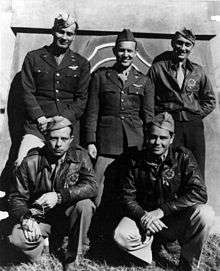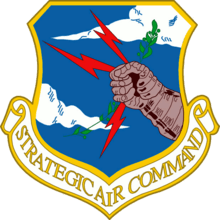Bruce K. Holloway
General Bruce Keener Holloway (September 1, 1912 – September 30, 1999) was a United States Air Force general. A West Point graduate, he was a fighter ace with the United States Army Air Forces in World War II and later served as Vice Chief of Staff of the United States Air Force and commander-in-chief of the Strategic Air Command.
Bruce K. Holloway | |
|---|---|
.jpg) General Bruce K. Holloway | |
| Born | September 1, 1912 Knoxville, Tennessee |
| Died | September 30, 1999 (aged 87) Orlando, Florida |
| Allegiance | United States |
| Service/ | United States Army Air Forces United States Air Force |
| Years of service | 1937–1972 |
| Rank | General |
| Commands held | Strategic Air Command (1968–72) U.S. Air Forces in Europe (1965–66) |
| Battles/wars | World War II |
| Awards | Air Force Distinguished Service Medal (2) Army Distinguished Service Medal Silver Star Legion of Merit (2) Distinguished Flying Cross (2) Air Medal (3) |
Early life and career
Holloway was one of two children born to Frank P. Holloway, a mill owner, and Elizabeth Keener, a homemaker. He graduated from Knoxville High School in 1929 and studied engineering for two years at the University of Tennessee before attending Marion Military Institute, preparing for appointment to the United States Military Academy, where he graduated in 1937. Assigned to the Army Air Corps, he received his pilot wings in 1938 at Kelly Field, San Antonio, Texas, then served two years with the Sixth Pursuit Squadron and 18th Pursuit Group in Hawaii before taking a postgraduate course in aeronautical engineering at the California Institute of Technology.[1][2]
World War II

After The US entered World War II in December 1941, Holloway was sent to China to observe Chennault's American Volunteer Group (AVG), the Flying Tigers. He became the commander of the 23rd Fighter Group USAAF. During his China tour, Holloway earned status as a fighter ace, shooting down 13 Japanese planes.[3][4] He returned to the US in 1944.
Post-war
As commander of the Army Air Forces' first jet-equipped fighter group in 1946, Holloway pioneered in this new field of tactical jet air operations.
After graduation from the National War College in 1951, he progressed through key staff assignments in both operations and development fields at Headquarters U.S. Air Force. Later, as director of operational requirements, he played a key role in preparing and evaluating proposals for many aircraft and missiles.
Holloway spent four years in Tactical Air Command (TAC) as deputy commander of both the 9th and 12th Air Forces, and in 1961 he was named deputy commander in chief of the U.S. Strike Command at MacDill Air Force Base, Florida. Later in that assignment, he also fulfilled additional responsibilities as deputy commander in chief of the Middle East/Southern Asia and Africa South of the Sahara Command.[5]
Senior commands and retirement
General Holloway assumed command of the U.S. Air Forces in Europe in July 1965, serving in that capacity until his appointment as Vice Chief of Staff of the United States Air Force on August 1, 1966 at The Pentagon. He became commander-in-chief of the Strategic Air Command at Offutt Air Force Base, Nebraska, on August 1, 1968, and remained in that position until retiring from the Air Force on 30 April 1972.
Holloway died of heart failure at age 87 in Orlando, Florida on 30 September 1999. His remains were cremated and interred in his hometown of Knoxville, Tennessee.
Awards and decorations
Holloway's decorations include the Army Distinguished Service Medal, Air Force Distinguished Service Medal, Silver Star, Legion of Merit, Distinguished Flying Cross, Air Medal, and foreign decorations which include the Order of the Sacred Tripod (China), Order of the Cloud and Banner, Chinese Air Force Pilot Wings, The Grand Cross of the Order of Merit of the Federal Republic of Germany with Star and Sash, German Air Force Command Pilot Wings, The Most Noble Order of the Crown of Thailand-First Class—Knight Grand Cross, Honorary Royal Thai Air Force Wings, the Order of Aeronautical Merit (Brazil), and Commander of the French Légion d'honneur.
See also
References
![]()
- Marion Military Institute – archives – April 2009 – Bruce K. Holloway '33 – accessed 31 October 2010
- Jackson, Kenneth T.; Markoe, Karen; Markoe, Arnie (2001). The Scribner Encyclopedia of American Lives: 1997–1999. Gale / Cengage Learning. p. 267. ISBN 978-0-684-80663-1.
- Air Force magazine – "Valor: Flying Tiger" – Bruce Holloway – April 1993 – accessed 31 October 2010
- One memorable flight over Kunming on 15 May 1943 is described in Edward H. Sims' book American Aces in Great Fighter Battles of World War II as the third chapter of that documentary.
- "AF.mil". Archived from the original on 2010-04-13. Retrieved 2010-11-01. – General Bruce K. Holloway – official USAF biography – 1968 – accessed 31 October 2010
External links
- The New York Times – obituary – Bruce K. Holloway – 9 October 1999-10-09. Accessed 31 October 2010
- Speech delivered by Bruce K. Holloway to the Comstock Club of Sacramento, California on May 22, 1967
| Military offices | ||
|---|---|---|
| Preceded by Joseph J. Nazzaro |
Commander-in-Chief, Strategic Air Command 1968–1972 |
Succeeded by John C. Meyer |
| Preceded by William H. Blanchard |
Vice Chief of Staff of the United States Air Force 1966–1968 |
Succeeded by John Dale Ryan |
